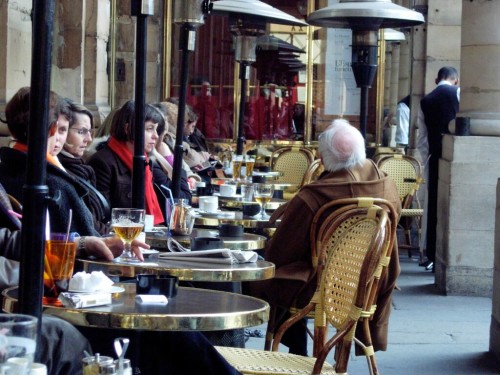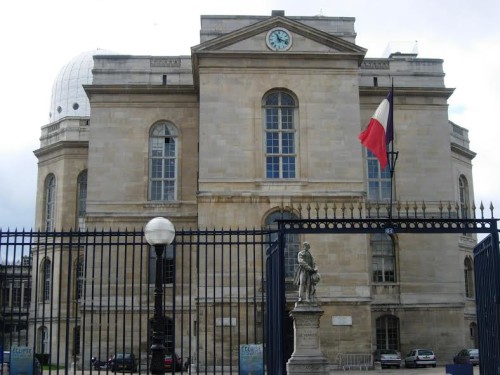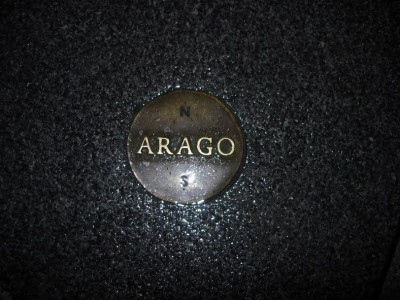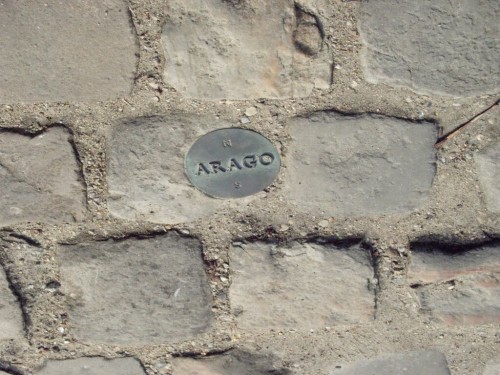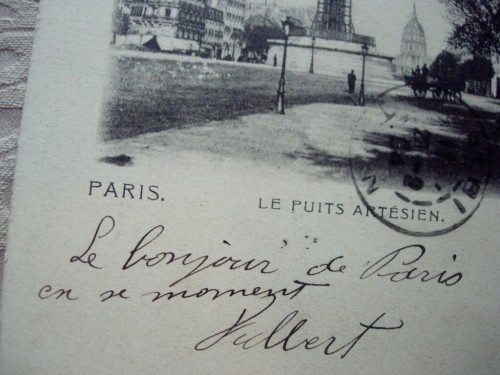
This is Part II of a two part homage to the strength and beauty that is Paris, its cultural diversity, its artistry, and its many revolutions—then, now, and always. Click here for Part I: Following La Meridienne de Paris and meeting François Arago.
At the café in Place Colette, I took the only empty seat in the line of tables against the outside wall. Sipping my bitter espresso and nibbling my square of dark chocolate, I tried to look casual as I peered under the adjacent table legs. When the waiter came by, I flagged him down. “Your Arago – do you still have it?”
“Of course!” he replied conspiratorially, discreetly pointing to the pavement a few tables down. “We protect it!”
All that time, as I walked the Meridian, the medallions were talismans of my connection to Paris and to French cartography. François Arago? I assumed his life had been uneventful and boring. Then I found myself back in Paris for a cold rainy month and decided to read Arago’s memoir. I should know better, of course. You have to take a memoir with a grain of salt, especially one written by an old man about his youth. But from the first lines, I fell hard for François. He was writing his autobiography, he said, to set the record straight. Certain other people had written about him and gotten it wrong, claiming he couldn’t read and write until he was fourteen, which he felt cast his family in a bad light, and accusing him of taking part in the excesses of the Revolution, when, if one just looked at the dates, he had been a small boy. His tone, at once peeved and rational, pulled me right in. I knew just how he felt because I felt the same way when I saw the Da Vinci Code fans looking down at the medallions and exclaiming about the Rose Line.
François turned out to be a gregarious southerner, a witty storyteller, a Romantic whose friends included poets, novelists, and sculptors. Born in 1786, three years before the storming of the Bastille, he was the oldest son of a pious mother known for her charitable good works and a father who worked as a public official in Rousillon. He detested monarchy and aristocratic privilege, was tall, dark, and handsome, and liked long walks across Paris. As a boy he dreamed of joining the military and defending the French Republic. He taught himself higher mathematics and passed the exam to enter the military engineering school in Paris, the elite but egalitarian Ecole Polytechnique. By then it was 1804 and the Revolution was over. Napoleon ruled France, dreamed of conquering the rest of Europe, and was counting on the Ecole Polytechnique to train his future generals.
Arago was still a student when he began to work at the Observatory. In 1806, when he was only twenty, he and another young researcher, Jean-Baptiste Biot, volunteered to travel to Spain to measure the Paris Meridian southward. The previous scientist had died in Spain of malaria, leaving the work incomplete. In the rugged terrain of the Pyrenees Mountains, the two young men and their assistants struggled to continue the chain of observations. Lighting bonfires on hilltops at night, they tried to fix the locations of the flames across some of the longest distances ever surveyed. When they were almost finished, Biot returned to Paris, leaving Arago and an assistant to complete the final observations on the Spanish island of Mallorca.
But when Napoleon invaded Spain, the Iberian Peninsula erupted in turmoil, and a Frenchman lighting signal fires above the harbor at night must surely be a spy. Arago had grown up speaking Catalan, so he managed to escape one mob by addressing them in the local dialect. (“The Frenchman? He’s up there! Keep climbing and good luck grabbing the bastard!”) He ran down the hill and into another armed mob, so he fled to the fortress and begged to be imprisoned for his own protection. While there, he read in a Spanish newspaper about his own execution by hanging. He was pleased to learn he had faced death bravely, but, since they talk of my death, he thought, the real event will not be long in coming.
The French port of Marseille was only a few days away, but ships no longer went directly. The Spanish commander looked the other way as Arago escaped the fortress on a fishing boat. He made it to Algiers, and when the next ship left for Marseille, he was on it disguised as a Hungarian merchant, along with two lions and a troop of monkeys the ruler of Algiers, the Dey, was sending as a gift to Napoleon. But when Spanish pirates captured the ship, the passengers were thrown into a Spanish prison. Arago managed to smuggle out a letter to the Dey to inform him that humans and beasts alike were starving; one lion had died and the other was skin and bones. The Dey insisted the ship and its passengers be released at once.
Courtesy of the authorThe Spanish complied, and with the surviving lion and the monkeys, they set off again, but within sight of Marseille, a storm blew up. They were blown all the way back to the North African coast and their ship was badly damaged. Rather than wait for it to be repaired, Arago decided to travel overland to Algiers disguised as a Muslim, although he was warned he would be put to death if he were found out. He reached Algiers, but before he could convert to Islam as he had promised his guides, he was taken hostage. His Dey of the lions had been beheaded and his successor was in a standoff with the French. When the incident was finally resolved, Arago again took passage for Marseille. For the third time, the harbor was in sight when they were intercepted by an English blockade. This time they had better luck and the English let the Algerian ship pass. A journey that should have taken a week had lasted nearly a year.
The French scientific establishment assumed he was dead and his pious mother was having masses said for his soul, so when twenty-three-year-old Arago landed in Marseille, a young Odysseus with a tale of adventure and the measurements of the Paris Meridian stuffed in his shirt, he caused a sensation. Scientific explorers were the cultural heroes of their day, and the most famous, Alexander von Humboldt, befriended and championed Arago and he was elected to the Academy of Sciences ahead of his older, more experienced colleagues.
He went on to become the quintessential French scientist of the nineteenth century. He proved the wave theory of light, studied electromagnetism, concluded that the surface of the sun was composed of hot gases, and worked on practical innovations including lighthouses, steam power, and waterworks. He collaborated fruitfully with Ampère, Fresnel, and with Humboldt, who counted him as his dearest friend and wrote him a thousand letters in his miniature script. Humboldt and Arago were fascinated with every aspect of the Earth – wind patterns, waterspouts, thunder, ocean currents. They persuaded ship captains to gather data for them and shot a cannon across Paris to measure the speed of sound. They were especially interested in the Earth’s temperature and climate. Did the Earth’s climate change over time and could human activity affect it? Arago suspected it could, citing the effects of deforestation. He recommended further research.
Courtesy of the authorThe government required its astronomers to offer a class for the public, and for thirty-three years, Arago was its enthusiastic teacher. He promised to explain all the mathematics necessary in the first few lessons. “Everybody knows what is meant by a straight line and a curved line,” he began, standing in front of a large chalkboard. So many Parisians attended that no classroom could hold them; he persuaded the government to build an auditorium at the Observatory that seated eight hundred. His collected lectures, published as Popular Astronomy, were one of the first books of popular science.
In July 1830 Arago was elected Permanent Secretary of the mathematics section of the Academy of Sciences, a lifetime appointment. When he arrived at the Academy on his first day as Secretary, he learned that King Charles X had just issued a reactionary edict that curtailed freedom of the press, dissolved the elected Chamber of Deputies, revised the electoral laws making even fewer men eligible to vote or run for office, and limited religious freedom. The king was reneging on the constitutional charter, the foundational agreement under which he reigned.
An important part of Arago’s job as Secretary was to deliver obituaries for departed distinguished scientists, and for his first, he had written an elegy to his collaborator and friend, Augustin Fresnel, whose improved lamps in lighthouses had reduced the number of shipwrecks off the French coast and saved many lives. Arago quickly inserted several passages about Fresnel’s love of free expression and his belief in the importance of the constitutional charter. This bit of improvisation delighted the republican members of the audience, including his own younger brother, who was far more radical than François. The next day, Paris erupted. The July Revolution, in which Arago’s younger brother Etienne played a major role, lasted three days. The heavy-handed Charles X was forced to abdicate and the more moderate Louis-Philippe became king. The constitutional charter was reinstated.
Courtesy of the authorA compelling orator with a thundering voice who never hesitated to give his opinion, Arago was ideally suited for the post of Secretary. His scientific interests were wide-ranging and once he had identified a new area of research, he was happy to pass it off to one of his colleagues and move on. He opened the meetings of the Academy to journalists and urged them to write scientific “soap operas” about the latest discoveries in their newspapers. He encouraged inventors, and played a pivotal role in the development of photography by advocating for Louis Daguerre, who had developed a process to fix images on glass plates but could find no one to invest in his invention. He suggested that Le Verrier investigate a wobble in the orbit of Uranus, which led to the discovery of Neptune. Le Verrier, a heartless man, repaid Arago by trying to depose him as Director of the Observatory. Jules Verne based a character on Arago and Victor Hugo wrote about looking at the moon through his telescope.
In 1830, after the July Revolution, Arago was elected to the Chamber of Deputies, and at forty-four, his second life as a scientist in politics began. Arago spent his childhood in the revolution, his young adulthood in Napoleon’s military empire, and his middle age in a constitutional monarchy. To be alive, he understood, was to be political. He was always quick to acknowledge that he owed his remarkable life to the Revolution and one of its republican institutions, the Ecole Polytechnique, where a boy from the provinces, without money or connections, could receive the best possible education simply by acing an exam.
As a Deputy, he advocated patent protection for inventors and lectured his fellow deputies at great length about the telegraph, steam power, railways, and safe drinking water. Although he lived in the rarefied intellectual atmosphere of the Observatory and the Academy, in May 1840, he gave a remarkable speech in the Chamber of Deputies about the miserable conditions of the working class. He advocated for the right of workers to organize and for electoral reform—one man, one vote. “I maintain, myself, that the principle of popular sovereignty is nothing but an empty word in any country where, among forty men, only one has the vote.” He went on, “It has been said that the citizens for whom we demand the right of suffrage do not have sufficient capacity to exercise it.” But, he demanded, did they need to take an exam? “The capacity that a voter must possess is being able to distinguish an honest man from a crook, the good citizen from the egotist, the man who has no personal agenda from the ambitious one…” Ten thousand workers marched to the gates of the Observatory to thank him.
In February 1848, revolution once again threw Paris into turmoil. The king abdicated and went into exile and a provisional government was named: Arago and ten others, ratified by cheers from the crowd in front of City Hall. For the second time, France was a republic!
The provisional government, led by the poet Alphonse Lamartine, adopted universal male suffrage, as Arago had advocated, ended the death penalty for political crimes, penalized Parisian employers who made their employees work more than ten hours a day, and guaranteed work to the unemployed men of Paris through national workshops. George Sand, the female novelist who often wore men’s clothing, wrote the government’s press bulletins, to Arago’s chagrin, as he felt they inflamed the already tense city.
Courtesy of the authorAs Minister of the Navy and the Colonies, and later as Minister of Defense, he ended flogging and improved conditions for sailors on Navy ships, and appointed an abolitionist, Victor Schoelcher, to resolve the question of slavery. His most important political accomplishment was the decree to abolish slavery in the French colonies, which he signed April 27, 1848. “Let’s hasten to do the good we can,” he remarked. “Tomorrow it may be too late.”
This was prescient because in late April elections were held, and the new, more conservative Assembly elected an Executive Commission of five members to choose the ministers and run the government. Arago received the most votes and was head of state. His tenure lasted forty-six days. Caught between the demands of the conservatives in the Assembly and the workers who had flooded Paris to join the government workshops, he and his government vacillated. They failed to comprehend the desperation and anger of the unemployed workers who were facing rising food prices, and in late June they gave in to the Assembly’s demand to disband the work program. Unemployed single men had to join the army or leave for public works projects in the provinces. On June 23, 1848, workers took up arms against the Second Republic and barricaded the streets of Paris.
It is said the white-haired Arago himself went out with some troops to talk to the insurgents. He walked up to a barricade and asked why they were battling their own republic. They replied, “Monsieur Arago, we have nothing but respect for you, but you have no right to reproach us. You have never been hungry. You don’t know what it is, misery.”
Arago’s name is on a Parisian boulevard and a crater on the moon, the Eiffel Tower, a ring around Neptune, a Smithsonian Institution database, an explanation of diffraction called Arago’s Spot, and the Paris Meridian.
The story goes that he replied, “We did what we could,” that a bullet whizzed by, that he retreated to safety, and with tears in his eyes, gave the order to attack and dismantle the barricades. The following day, the Assembly handed executive power to General Eugène Cavaignac, who brutally suppressed the uprising. Perhaps as many as four thousand citizens were killed and many more wounded. Prisoners were executed in the Luxembourg Gardens at night, and the gates were locked until rains came and washed away the blood. Disillusioned, frail, and nearly blind from diabetes, Arago retreated to the Observatory. Victor Hugo remarked, “When one has these two specialties, to look at the sky and to look at the ground, I understand that he prefers the first.”
When presidential elections were held in December 1848, the newly enfranchised voters betrayed Arago’s faith in their judgment. In a landslide, they elected an egotistical and ambitious crook with a gilded name, Louis-Napoleon Bonaparte, nephew of Napoleon. In 1852 he declared himself Emperor Napoleon III and demanded that every public official swear an oath of loyalty. Arago sent his resignation instead. Napoleon III overlooked this and he was allowed to stay on as Director of the Observatory. He died there the following year. Forty thousand mourners followed his casket to the cemetery.
Arago’s name is on a Parisian boulevard and a crater on the moon, the Eiffel Tower, a ring around Neptune, a Smithsonian Institution database, an explanation of diffraction called Arago’s Spot, and the Paris Meridian. But the particulars of his life—his facility for collaborating with and mentoring his colleagues, his integration of science and politics, his role in the revolution of 1848 and the abolition of slavery, his pioneering efforts to popularize science—have been forgotten. How did someone so famous fall through the cracks of history? He never made one of those large scientific discoveries that ensure immortality and his revolution was a failure. Historians consigned him to science and scientists preferred not to mention his political career.
Courtesy of the authorWhenever I have the good fortune to be back in Paris, I walk the Meridian. I no longer need the medallions to find my way, a good thing, since with a few exceptions, the only ones that remain are locked inside gates at night, in parks, the Louvre, and the Palais Royal. In Paris, any walk passes through time as well as space, so it isn’t a surprise when François falls in beside me as I pass the Observatory.
He knows that later scientists used the disastrous end of his political career to justify the notion that scientists should stay inside their laboratories and keep silent. As we walk, he points out the weakness in their logic: to retreat from the world will not necessarily make you a better scientist. Nor does the failure of his revolution make the republic a less worthy goal. I fill him in on what happened after his death, how his younger brother and son took part in yet another revolution in 1870 that successfully created the Third Republic, which lasted until the German occupation and Vichy. I can’t resist adding that women now vote and are elected to office, and to the Academy for their contributions to science. His thick black eyebrows rise briefly in astonishment.
As we walk, I do my best to describe how the planet is warming, the icecaps are melting, and the sea level rising. And everywhere on the globe it is the poor who are most vulnerable to the disasters that ensue. He takes this in soberly. His Paris was the epicenter of scientific breakthroughs and political upheavals, and remarkably, he was central to both. Now, once again, scientists and political leaders are gathering in Paris to discuss the precarious state of the Earth. If Arago and his friend Humboldt were to pull up in a carriage to the climate summit, they would browbeat the leaders into taking action. But in our world there is no one quite like François Arago.
The work of understanding our planet is never completed, François tells me with a flash of his dark eyes, simply passed down to the next generation. And as for improving conditions for the humans who live on it, he knows how difficult that is. “Let’s hasten to do the good we can,” he says. “Tomorrow it may be too late.” And having made his point, he presses my hand gallantly and disappears inside the Academy. I continue on alone, crossing the river on the Pont des Arts, walking north along the Meridian and forward into time.
Carol Spindel is the author of In the Shadow of the Sacred Grove, a New York Times Notable Book, and Dancing at Halftime: Sports and the Controversy Over American Indian Mascots. Her award-winning commentaries have aired on NPR and her essays and book reviews have appeared in many places, including Oxford American and African Arts. She teaches nonfiction writing at the University of Illinois and the Iowa Summer Writing Festival


